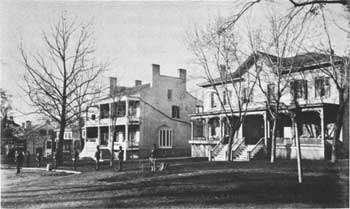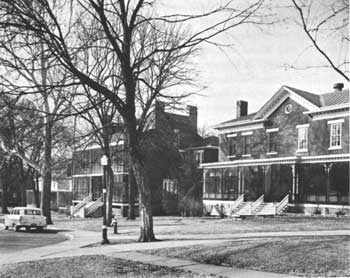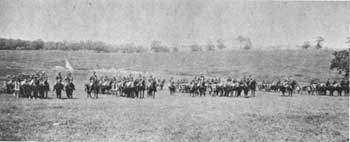





Survey of Historic Sites and Buildings
 |
FORT LEAVENWORTH Kansas |
 |
| ||
This fort on the west bank of the Missouri River, the oldest active Army post west of the Mississippi, is one of the most historic in the West and in the Nation. From the time of its founding in 1827 to the present it has been a front-ranking military installation. Centrally located on the main westward travel routes in the 19th century, it was a troop and transportation center, supply depot, and exploration base that figured prominently in the Plains campaigns against the Indians and the Mexican and Civil Wars. A modern training center, it has also supported the wars of the 20th century.
As early as 1824 Missouri citizens petitioned Congress to activate a military post at the Arkansas Crossing of the Santa Fe Trail to protect traders. Three years later, in a more defensible and logistically supportable location, just over the western boundary of Missouri and about 300 miles northeast of the crossing, Col. Henry Leavenworth founded the fort that came to bear his name. From 1827 until 1839 it was headquarters for the Upper Missouri Indian Agency, which had jurisdiction over all the tribes in the Upper Missouri and northern Plains region, and was the scene of many conferences and treaty councils. The garrison also inspected Missouri River steamboats to prevent the smuggling of alcohol to the Indians.
  |
| Then and now view at Fort Leavenworth. The building at left, residence of the commanding officer from 1837 until 1890, is still used as an officers' quarters. The house at right was erected about 1870. (U.S. Army, Department of Defense) |
Replacing Fort Atkinson, Nebr., on the "Permanent Indian Frontier," the fort guarded the Santa Fe Trail and quelled Indian disturbances. The 1st Dragoons, mounted troops activated for use on the frontier to counter the mounted tactics of the Indians, came to the fort in 1834, the year after Congress established a regiment of 10 companies on an experimental basis. The regiment proved so effective that in 1836 Congress founded a second one. For three decades prior to the Civil War, particularly, the fort's location near the eastern termini of the Santa Fe and Oregon-California Trails made it a key frontier post and transportation mecca. The firm of Russell, Majors, and Waddell, which beginning in 1854 took over the transportation of supplies to all Army posts west of the Missouri, maintained its headquarters nearby.
Exploring expeditions that used Fort Leavenworth as a base of operations between 1829 and 1845 included Maj. Bennett Riley's 1829 reconnaissance of the Santa Fe Trail to the Mexican border; Col. Henry Dodge's peacemaking mission in 1835 among the southern Plains tribes, during which three companies of dragoons in 3-1/2 months marched 1,600 miles to the Rockies via the Oregon-California Trail and returned via the Santa Fe Trail; and Col. Stephen W. Kearny's expedition to the southern Plains and the Rockies in 1845, which sought to impress the Indians with U.S. military prowess, gathered information on the Plains country, and escorted caravans over the Oregon-California and Santa Fe Trails.
During the Mexican War (1846-48), the fort was the base for General Kearny's Army of the West, which occupied New Mexico and California. Following the war, it was the chief supply depot for western Army posts. It was also the base of the Loring Expedition. In 1849 Lt. Col. William W. Loring led the Regiment of Mounted Riflemen westward; bought Fort Laramie, Wyo., from the American Fur Co.; founded Cantonment Loring, Idaho; and helped garrison Fort Vancouver, Wash. The year before, the regiment had helped man the second Fort Kearny, Nebr., also along the Oregon Trail. The regiment had been organized 2 years earlier specifically for Indian and Oregon-California Trail duty, but had been diverted to the Mexican War.
 |
| Artillery maneuvers at Fort Leavenworth in 1884. (National Archives) |
In October 1854 the first Territorial Governor of Kansas, Andrew H. Reeder, was inaugurated at the fort. Preferring its protective defenses, he maintained offices there for a few months before moving to Shawnee Mission, Kans. By this time settlers had begun to push into the area, and the town of Leavenworth soon sprang up adjacent to the fort.
After the Civil War, by which time the frontier had advanced well beyond the fort, it continued as a quartermaster depot and ordnance arsenal. In 1881 it became a school for infantry and cavalry officers, reorganized in 1901 as the General Service and Staff School. During the 20th century, it remained an officers' school, and in World Wars I and II served as an induction and training center. Today it is the headquarters of the Command and General Staff College.
Numerous historic structures, scattered among modern ones, are practically all still in use. Marked by the Army, they include the present post headquarters, a complex of four brick buildings, two built in 1859 as arsenal shops and two in the early 1900's; the commanding general's home, constructed in 1861 as the arsenal commandant's residence and considerably remodeled since; the sutler's house (1841), a log building that has been covered with a frame exterior and altered by the addition of a second story and is today occupied by the assistant commandant of the Command and General Staff College; a stone chapel (1878); the stone buildings of the U.S. Disciplinary Barracks, a military prison founded in 1874; the "Rookery," dating from the early 1830's and enlarged in 1879, which was the first permanent post headquarters, in 1854 the temporary residence of Kansas' first Territoral Governor, and is today an officers' quarters; a double officers' quarters (1837), the home of the post commander between 1840 and 1890; the "Syracuse houses" (1855), two identical frame officers' quarters; and the present Army Bank Building, likely built in the late 1870's, once the post headquarters and later used for school purposes. Well-defined ruts of a variant route of the Oregon-California Trail run from the old fort area to the river's edge. The Army maintains a museum devoted to the post's history. The cemetery contains many burials dating from the Indian wars.
NHL Designation: 12/19/60
 |
 |
http://www.cr.nps.gov/history/online_books/soldier-brave/siteb7.htm
Last Updated: 19-Aug-2005